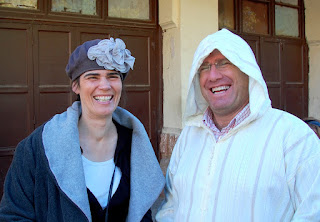Day 3
We were up this AM at 6:30 for Shacharit which we davened together with 11 local Fes Jews in the one remaining most beautiful shul. - just remember that Fes has a total of 150 Jews of which about 60 are men which means that close to 20% of the male population of Fes came to shul this morning - amazing!!!
The local Rav began the tefillah by reciting out loud numerous Tehillim and the entire karbanot baal peh with the sefaradic nussach
The davening took very long but it was most meaningful to be able to connect with some of the remaining Jews of Fes. At the end of the tefillah, rabbi Garson spoke to them and told them that their dedication was an inspiration to all of us. The local Rav then blessed all of us.
After breakfast at the hotel, we drove to the Mellah of Fes and did a walking tour of the old Jewish quarter. We saw many old doorways with the old indentation where mezuzot once sat.
We then walked around the corner to the old Jewish cemetery where Rav Danan, Sulika Hatzadeket, and Rav Chaim Ibn Attar (the Gur Aryeh...famous story of the lion's den) are all buried.
Sulika is called the Rachel Imeinu of Moroccan Jewry because of her death al kiddush Hashem... today was the yartzeit of Rachel Imeinu.
Many people come from all over the world to pray at the kever of Sulika. Rav Garson and Zvi Sperber both spoke emotionally about the power of tefillah at kivrot tzaddikim and we all joined together to sing Mizmot lDavid and eishet chayil. It was a very emotional experience
From there we went into the Medina or the walls of the old city. The old city of Fes is very old with thousands of narrow alleyways. You can very easily get lost without a guide. Our guide took us into some of the artisans who have made the bazaar popular.
We visited a silversmith, a weaver, and a tannery. As you enter the tannery, they hand you some mint leaves that you smell to overcome the stench of the tannery. As in the Mishneh the tannery is on the eastern side of the city, which is where the poor people live. We have amazing pictures of the whole process
We visited a silversmith, a weaver, and a tannery. As you enter the tannery, they hand you some mint leaves that you smell to overcome the stench of the tannery. As in the Mishneh the tannery is on the eastern side of the city, which is where the poor people live. We have amazing pictures of the whole process
In each of these artisan shops, the art of bargaining is seen to the fullest. They ask for a price, you offer a quarter of asking and end up somewhere between a quarter and a half.
We spent a few hours in the alleyways and then began the long trek thru the mountains to Afouer which is high in the Middle Atlas Mountains. We have a two to three hour drive back to Marrakesh for our last day here tomorrow
It has been a very bittersweet trip. On the one hand we have learned about the richness of Morroccan Jewry, the warm traditions, the amazing Shuls, the famous tzaddikim and baalei mofes, and the pride that they have had in their culture. On the other hand we have seen how it is quickly disappearing, and how there are but a handful of Jews in places like Meknes, Fes, and Marrakesh that were once major centers of Jewish culture and learning. It has truly been a rollercoaster of emotions.
































No comments:
Post a Comment